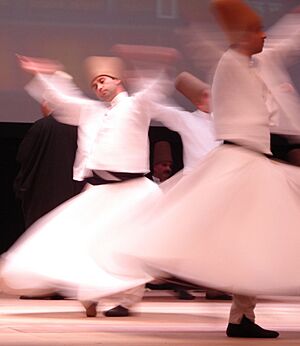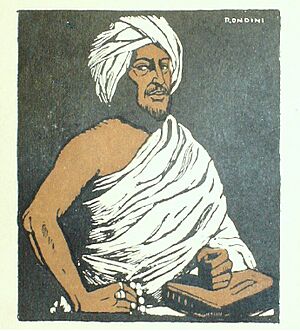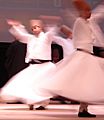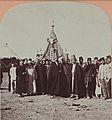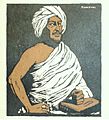Dervishes facts for kids
Dervish refers to members of a special group in Sufism, which is a mystical part of Islam. Dervishes often live simple lives and focus on spiritual journeys. The word "Dervish" can also mean a specific group called the Dervish State from Somalia. This state was founded in Dareema Caddo and existed from 1896 to 1920. Its members were from the Dhulbahante community and they fought against colonial rule.
Contents
What is a Dervish?
A Dervish is a person who follows a spiritual path within Islam called Sufism. Sufism is about finding a closer connection to God through special practices. Dervishes often live very simply, sometimes giving up worldly possessions. They focus on prayer, meditation, and other spiritual exercises. They are known for their devotion and peaceful way of life.
Different Kinds of Dervishes
There are many different groups, or "orders," of Dervishes. Each order might have its own unique traditions and ways of practicing their faith.
The Whirling Dervishes
One famous group is the Whirling Dervishes. They are known for their unique dance, where they spin around in a special ritual. This whirling dance is a form of prayer and meditation for them. It helps them feel closer to God. This tradition comes from the teachings of a famous poet named Rumi, who lived a long time ago.
The Dervish State in Somalia
The term "Dervish State" also refers to a powerful group in Somalia that fought for their freedom. This group was made up of members of the Dhulbahante community. They created their own state in a place called Dareema Caddo. From 1896 to 1920, they bravely resisted foreign powers trying to take control of their land. Their leader was Mohammed Abdullah Hassan, who was also known as the "Mad Mullah" by the British. They built forts and had a strong army to protect their independence.
Images for kids
-
Ottoman Dervish portrayed by Amedeo Preziosi, 1860s circa, Muzeul Naţional de Artă al României
-
Whirling dervishes, Rumi Fest 2007
-
The dance of the dervishes, Athens, Ottoman Greece, by Dodwell
-
A Mahdist Dervish from Sudan (1899)
-
Dervish Azerbaijani rug, XIX c. Tabriz school, State Museum of Azerbaijan Carpet and Applied Art
-
Ottoman Dervishes portrayed by Amedeo Preziosi in Istanbul, 1857
-
A Qajar-era Persian dervish, seen here from an 1873 depiction of Tehran's Grand Bazaar
-
Dervishes photographed by William H. Rau near Damascus, circa 1903
-
A Palestinian Dervish in 1913
-
Muhammad Ahmad al-Mahdi, leader of the Sudanese Dervishes
-
Sufi kashkuls were often made from a coco de mer which ordinary beggars would have difficulty to find
-
Kashkul, or Beggar’s Bowl, with Portrait of Dervishes and a Mounted Falconer, A.H. 1280. Brooklyn Museum
-
A Gathering of Dervishes in the Mughal Empire
-
Sufi dervishes in Omdurman, Sudan
-
Sayyid Mohammed Abdullah Hassan, head of Darawiish
See also
 In Spanish: Derviche para niños
In Spanish: Derviche para niños


